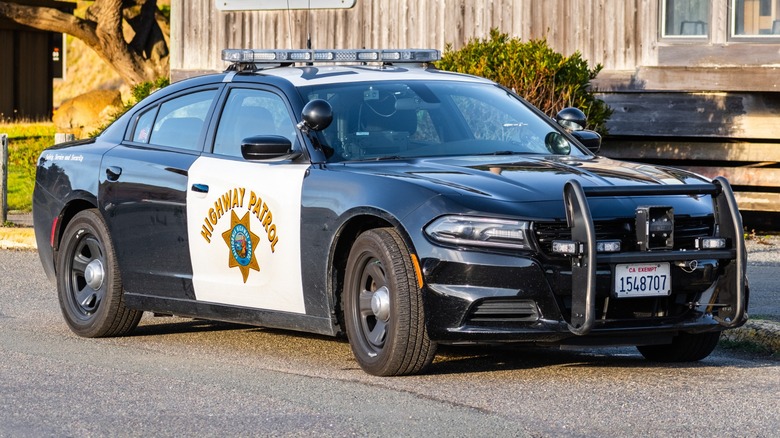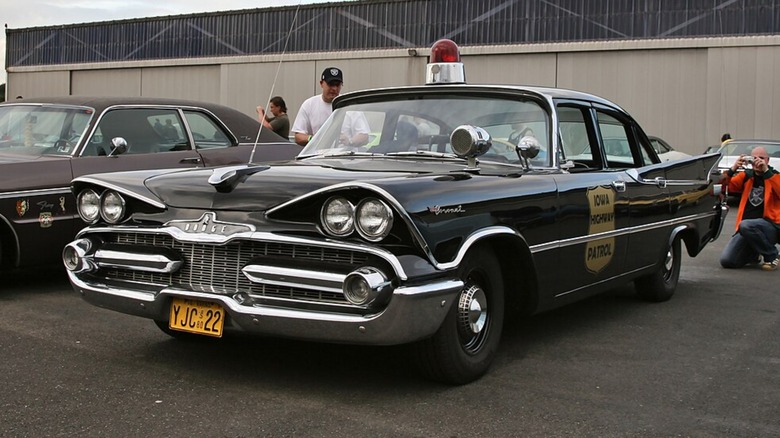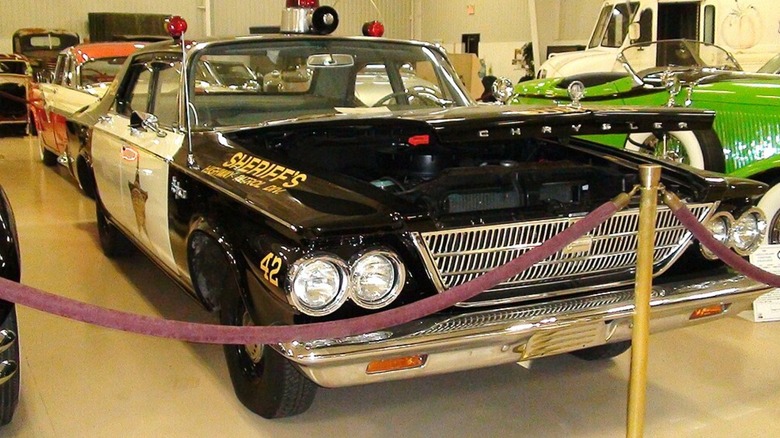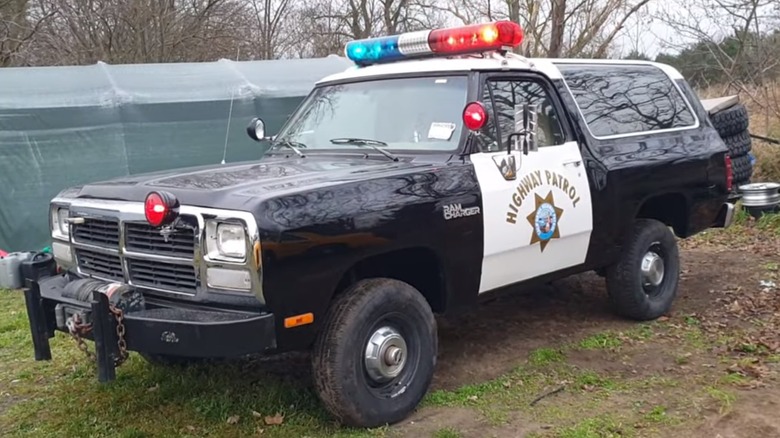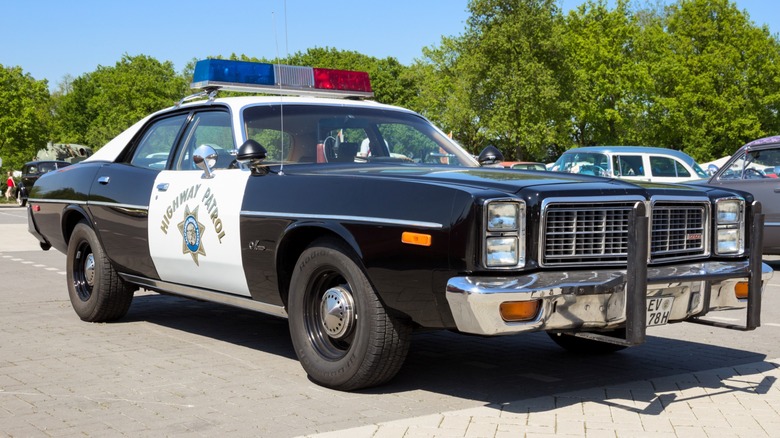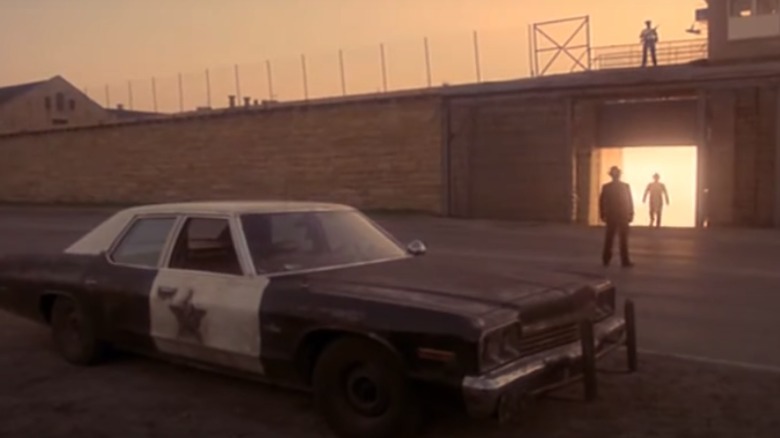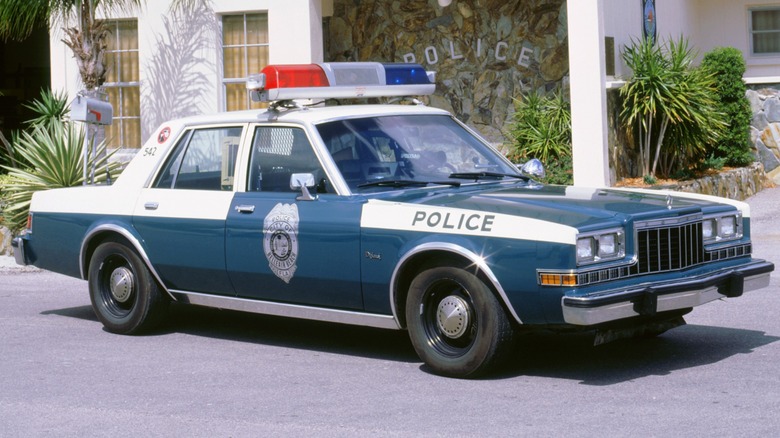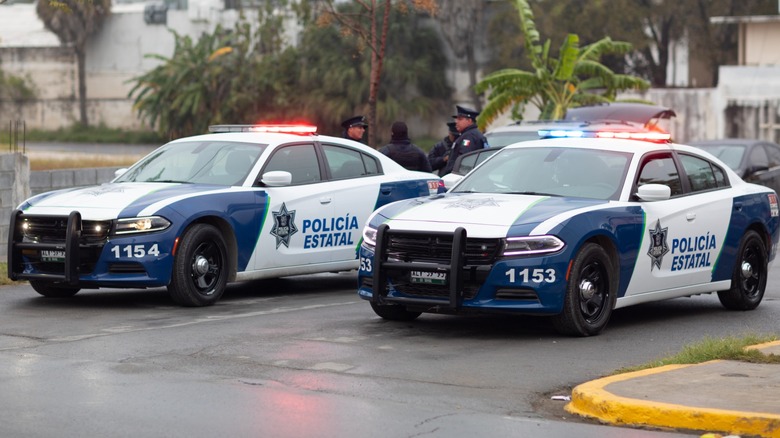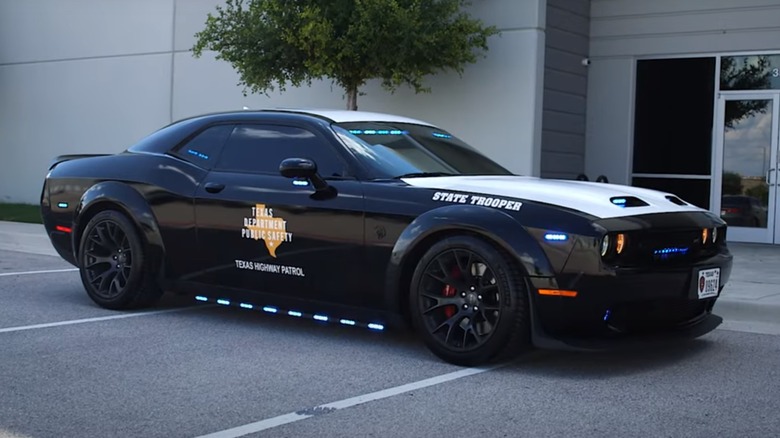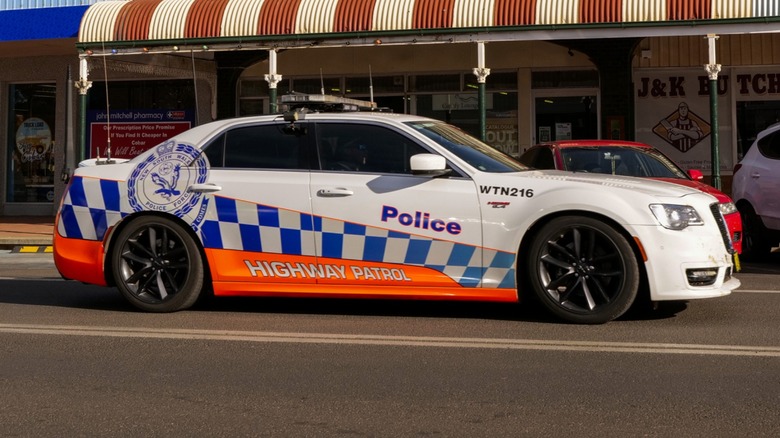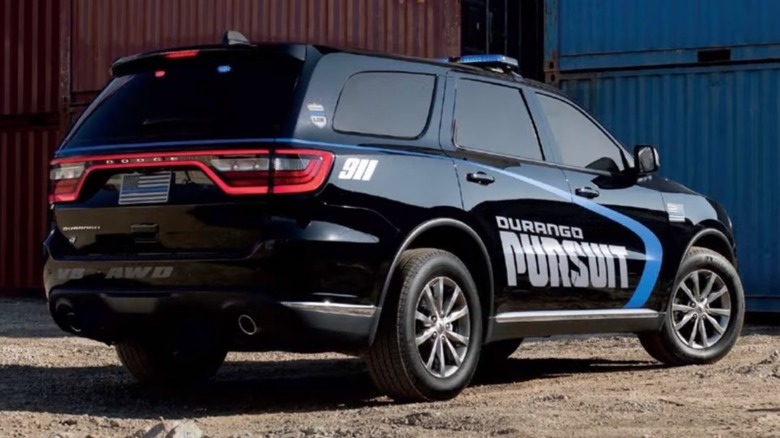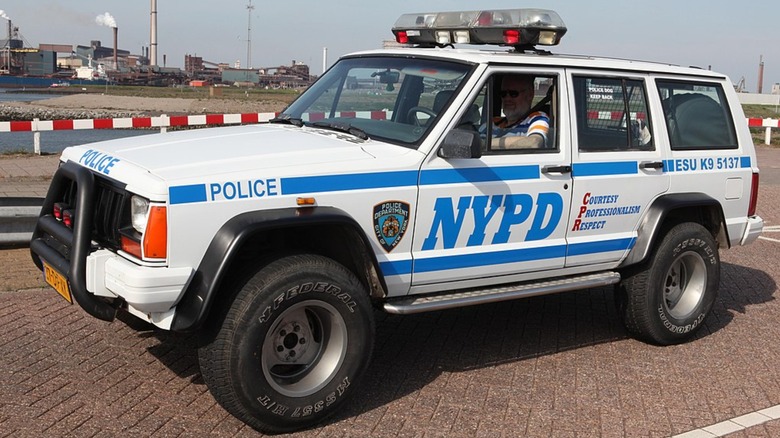10 Of The Most Iconic Chrysler, Plymouth And Dodge Police Cars Ever Made
Few machines roaming the world's streets are as ubiquitous and recognizable as the police car. Adopted early in the history of the automobile as a reliable and efficient means of getting officers on the streets they are tasked with patrolling, the police car has become a tool of the trade and an integral part of the job. However, police cars are generally not purpose-built specialty vehicles but standard production models adapted for police service, which makes them often a popular model straight from the showroom.
And while they take many forms across the world, American police cars tend to be a unique breed. Furthermore, while Ford and Chevrolet have both produced police cars for decades, those from the Chrysler Corporation have dominated the scene at different points over the decades, making them particularly recognizable.
The Chrysler Corporation, now part of Stellantis, has been making cars since the 1920s, acquiring brands such as Dodge and DeSoto along the way. As one of "The Big Three," Chrysler and its Dodge and Plymouth brands have accounted for a substantial portion of auto sales in North America as well as a not insignificant measure of sales elsewhere.
With such a dominant position in the industry, Chrysler vehicles, also often referred to as Mopar, represent some of the most common vehicles on the road, including police models. These officer-driven Mopar vehicles have been among the most iconic cars on the road. Here are 10 of the most iconic of them all.
1956–1959 Dodge Pursuit
This late 1950s Dodge sedan may not be the most recognized car Dodge ever created, but it does attain icon status for introducing the first police package from Chrysler as well as the Pursuit moniker. Police departments had used Dodge and Plymouth vehicles for years, but those were always regular production models outfitted by the departments for patrol duty. And with cars in the 1950s becoming faster and easier to drive at high speeds, police needed to keep up.
The first car from Chrysler was the Dodge Coronet 230 Pursuit. This model offered a bevy of upgrades, including heavy-duty brakes, stiffer springs, and shock absorbers, a faster steering ratio, roof bracket inserts to support externally mounted lights, antennas, and sirens, stain-resistant floor mats instead of cut-pile carpeting for longer wear, high-output electrical system, and much more.
Power came from a 315 Red Ram Hemi V8 with a Carter four-barrel carburetor good for 260 horsepower. Within a few years, more powerful options were offered, including the D-500 package, with a dual-carburetor 361 V8 producing 320 horsepower, although few departments ordered this due to cost and fuel economy.
[Featured image by Triple-Green via Wikimedia Commons | Cropped and scaled | CC BY 2.0]
1961–1964 Chrysler Enforcer
By the time Kennedy had beaten Nixon for the keys to the Oval Office, Dodge, DeSoto, and Plymouth offered police packages. But in 1961, the first police car from the higher-end Chrysler came out as the Chrysler Enforcer. Based on the full-size Newport sedan, the Enforcer offered police a large, comfortable car with plenty of room to haul equipment and perps to and from the station.
With the big Chrysler, officers were blessed with ample power thanks to the 383 cubic inch V8 engines under the hood. The California Highway Patrol chose the Enforcer but asked for a hotter cam and a Carter carburetor, replacing the usual Holley to give it a boost of power. As a result, the CHP cars could hit a top speed of 130 mph, something officers could use on the long stretches of California pavement.
While Enforcer might have been a big and relatively fancy car for patrol use, it did not last long. Chrysler ended the Enforcer model with the 1964 model year and left the production of service vehicles to Dodge and Plymouth.
[Featured image by Tino Rossini via Wikimedia Commons | Cropped and scaled | CC BY 2.0]
1974–1993 Dodge Ramcharger
For many police agencies around the country, particularly in the rural and mountainous West, a typical sedan is inadequate for patrolling some jurisdictions. The rugged and open terrain or the need to travel away from roadways makes it incumbent on those agencies to have vehicles that can adequately traverse rough terrain. To properly equip the officers charged with these areas, many departments opted for the Dodge Ramcharger, a four-wheel-drive SUV based on the Dodge Ram pickup.
Although many police and sheriff departments used these trucks, there is no information about specific police packages available. This means agencies bought base models and had them equipped for service duty. The early models were well suited for this as they came with no added equipment — even the passenger seat and rear bench were optional. It seems Dodge knew these were destined for service as rugged workhorses.
However, these made excellent vehicles for the places in which they were needed. In the mountains of Montana or Colorado, officers could be dispatched to help people hiking or camping in the wilderness or to chase down fugitives cutting through rural tracts of land while on the lam. As the era of the SUV and crossover began, these were discontinued and replaced with more modern models, often available with police packages from the factory.
1974–1978 Dodge Monaco
Though the Dodge Monaco was a model in production from 1965 through 1978, with a short-lived revival as an odd Renault-based badge-engineered model in the '90s, only the second generation merits any mention as an icon. This car was a full-size sedan and wagon, with the second generation being particularly large and generally not terribly attractive or noteworthy. It is a big car from the '70s that moved families from one place to another. Not much more could be said about it except for its unlikely star status on screen.
Perhaps the most famous cop car on the silver screen of all time is known as the Bluesmobile in "The Blues Brothers" movie. According to Elwood Blues, "It's got a cop motor, a 440 cubic inch plant, it's got cop tires, cop suspensions, cop shocks. It's a model made before catalytic converters, so it'll run good on regular gas. What do you say, is it the new Bluesmobile?" The 1974 Dodge Monaco is then thoroughly abused during what would be the most expensive movie car crash scene in history. A hundred and four cars were destroyed while filming the scene, of which 13 were the Bluesmobile.
Adding to the stardom of the Monaco was its inclusion on the small screen in the ever-popular show, "The Dukes of Hazzard." The bumbling and dim-witted sheriff Rosco P. Coltrane, sheriff of Hazzard, drives one of several Monaco models throughout the series, always accompanied by his hound dog, Flash.
1980–1989 Plymouth Gran Fury/Dodge Diplomat/Chrysler New Yorker
Chrysler introduced its new M-body sedan in 1977, with versions slated for all three marques under the Chrysler umbrella. The new platform underpinned a couple of new cars upon introduction, and starting in 1980, a trio of stout and dependable models came to be: the Dodge Diplomat, Plymouth Gran Fury, and Chrysler New Yorker.
While these cars became popular across a broad section of middle-class families, they became ubiquitous among fleets, especially with police departments. Ford and Chevrolet both offered police cars — the Mopar variants struck fear in the heart of many careless drivers through the early '90s as the vehicles attracted to be retired. The M-Body variants became wildly popular among American police departments in the '80s, with the Diplomat being the best-selling model by far.
Many departments preferred the Mopars as the car's size was a bit smaller and more maneuverable than the competition, and performance testing showed them to be quicker. Therefore, these are part of the entire American 1980s aesthetic, showing up prominently in TV shows and movies from or about the period and roaming the streets of the biggest cities. New York, which famously has a huge police department, used Mopars throughout the era.
2011–present Dodge Charger Pursuit
The current police package offered by Chrysler is also the only domestic police car available today. With Ford and Chevrolet eliminating cars almost altogether from their lineups, that leaves only the Dodge Charger Pursuit for departments that prefer a car over an SUV for patrols.
The current Pursuit model dates back to 2005, but its last major redesign was in 2011, making this model extraordinarily old in the auto industry. However, the power offered and the integration of special features are incomparable to earlier Mopar police cars. Base models come with V6 engines making 300 horsepower and optional HEMI V8 engines making 370, exceeding anything offered even in the muscle car era of the late '60s. Furthermore, the fuel efficiency rating of 18 MPG city / 27 MPG highway and 16 MPG city / 25 MPG for the HEMI were impossible in years gone by.
The list of special features for these cars is lengthy. Some specialized police add-ons include load-leveling and height control, 220-amp alternator, police-only power distribution center and wiring harness, ballistic door panels, and much more. The suspension systems are heavy-duty, and engines have robust cooling systems for extreme running conditions. But most of all, the Charger Pursuit is the coolest and baddest-looking police car ever made. While you don't want to see them in your rear-view mirror, they would not be so bad to be seen in.
2020 Dodge Challenger SRT Hellcat Redeye
Police have long opted to buy patrol cars with generous horsepower and upgraded suspension to give officers a level playing field when chasing hotrodders and baddies in sports cars. Some early examples of police specifically buying fast cars to patrol highways for traffic enforcement include the 1982 to 1993 Mustang SSP (Special Service Package), with highway patrol outfits all over the country using them to catch the most egregious speed infractions. Later, Chevrolet offered its Camaro B4C, touting a 159-mph top speed thanks to its marvelous LS1 V8 engine.
Sadly, Chrysler never offered one of its sports cars for police duty, but that has not stopped at least one department from recruiting one for duty. Specifically, the Texas Highway Patrol took possession of a Dodge that was driven by someone speeding who subsequently led police on a high-speed chase, racking up several felonies in the process, including street racing, evading, aggravated speeding, and illegal weapons possession. It was seized in connection with an arrest resulting in a conviction in April 2021.
The sports car in question happened to be a 2020 Dodge Challenger SRT Hellcat Redeye. Not only was it a Hellcat, but it was also upgraded and tuned to produce 1,080 horsepower. While 1,000 horsepower is overkill and ridiculous for a highway patrol, Texas troopers will be using it to roam the highways on occasion, but mostly using it for public relations and to promote safe driving. However, it is now a full-fledged black-and-white equipped with the reds-and-blues, so that makes it officially an iconic Dodge cop car, much like the department's first Dodge Challenger SRT patrol car, a 2013 SRT Challenger donated by Buffalo Bills player Mario Williams.
2018–2023 Chrysler 300 SRT
While brand hierarchy among automakers is generally well-defined, the brands of Chrysler are a bit more ambiguous and seemingly always have been. It is crystal clear that Lincoln is the luxury arm of Ford while Lexus is the luxury Toyota. Yet, Chrysler, despite being mostly more upscale than Dodge, does not compete with Cadillac, nor could Plymouth, before it folded, be considered either above or below Dodge. Nonetheless, Chryslers of late are more upscale than the more mainstream and sporty Dodge lineup. Therefore, no Chrysler has been offered with a police package since the 1960s, except in Australia.
Chrysler has a long history in the country, and the automotive culture is more similar to the United States than countries elsewhere. Furthermore, cities in Australia have no lack of space and avoid the tightly congested roads of the Old World. Therefore, large rear-wheel-drive cars with big V8 engines are well-suited to police work, which is why some police in New South Wales use Chrysler SRT 300 models for patrol.
These right-hand-drive vehicles were originally selected for duty in 2017 and feature 6.4-liter HEMI engines, producing an incredible 470 horsepower. With that kind of grunt, Aussie hoodlums should think twice about making a run into the outback in most cars available in the country. It seems a peculiar and relatively costly choice for a government vehicle, but was chosen to replace the outgoing Holden Commodore SS, another Australian V8 muscle car in service.
2019–present Ram Durango Pursuit
Although Dodge never offered the mighty Ramcharger with a police package, its successor brand, Ram, does offer the Durango Pursuit for law enforcement agencies. Ram initially offered its Durango in 2012 as a Special Service Vehicle (SSV). It was offered to police and fire departments and featured upgraded electrical, cooling, and braking components. However, something about the SSV package prevented it from properly competing with the Ford Explorer-based Interceptor and Chevrolet Tahoe PPV. Therefore, it was reintroduced in 2019 with the long-running Pursuit designation.
The new model received a few additional upgrades, including a performance-tuned suspension and a higher top speed of 118 mph. With a redesigned front fascia also came cooling ducts for the brakes and all-wheel-drive, preparing it for extended high-speed driving in strenuous conditions. It also comes equipped with tri-zone climate control, offering optimal temperature control specifically for K-9 units. Durango Pursuit models can be ordered with either the 3.6-liter Pentastar V6 or a 5.7-liter HEMI V8 with up to 360 horsepower. Seating is specially crafted to accommodate officer service belts up front, with hard plastic seats in the rear, and the shifter is moved to the column, leaving ample space for equipment in the center console area.
1992–2001 Jeep Cherokee Pursuit
Long before Ford made an SUV practically the default police cruiser with its Explorer Interceptor, Chrysler offered a similar model with the Jeep Pursuit from 1992 to 2001. The AHB Police Package was available on the XJ Cherokee model derived from the original AMC-designed vehicle that came out first in 1984. Like other Pursuit models, the Cherokee received several upgrades to make these already robust and durable vehicles ready for rugged police work.
Equipped with the legendary 4.0-liter AMC inline-6, the package also included thicker sway bars, a transmission cooler, column shift automatic transmission, gas shocks, anti-lock brakes, electrical upgrades, and the removal of the speed limiter, raising the top speed to 120 mph. Early testing by the Michigan State Police wowed evaluators with the excellent performance of the Cherokee, which outperformed contemporary police cruisers such as the Crown Victoria and Caprice in braking and acceleration. Of course, it came with four-wheel-drive meant for those officers in areas where cars would fail to perform up to standards.
The Cherokee proved to be popular with officers in many departments, but the model, both consumer and special service versions, was discontinued after 2001. The replacement, the Liberty, no longer offered a Pursuit model.
[Featured image by Joost J. Bakker via Wikimedia Commons | Cropped and scaled | CC BY 2.0]
